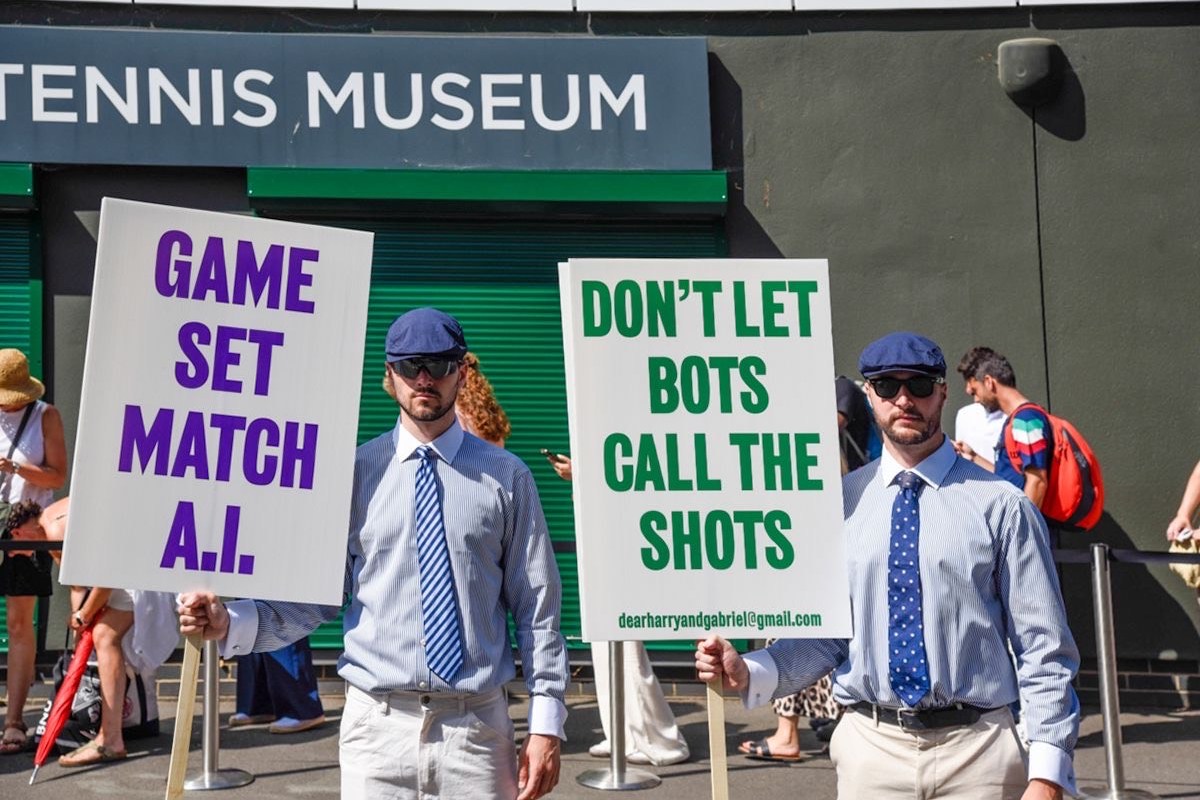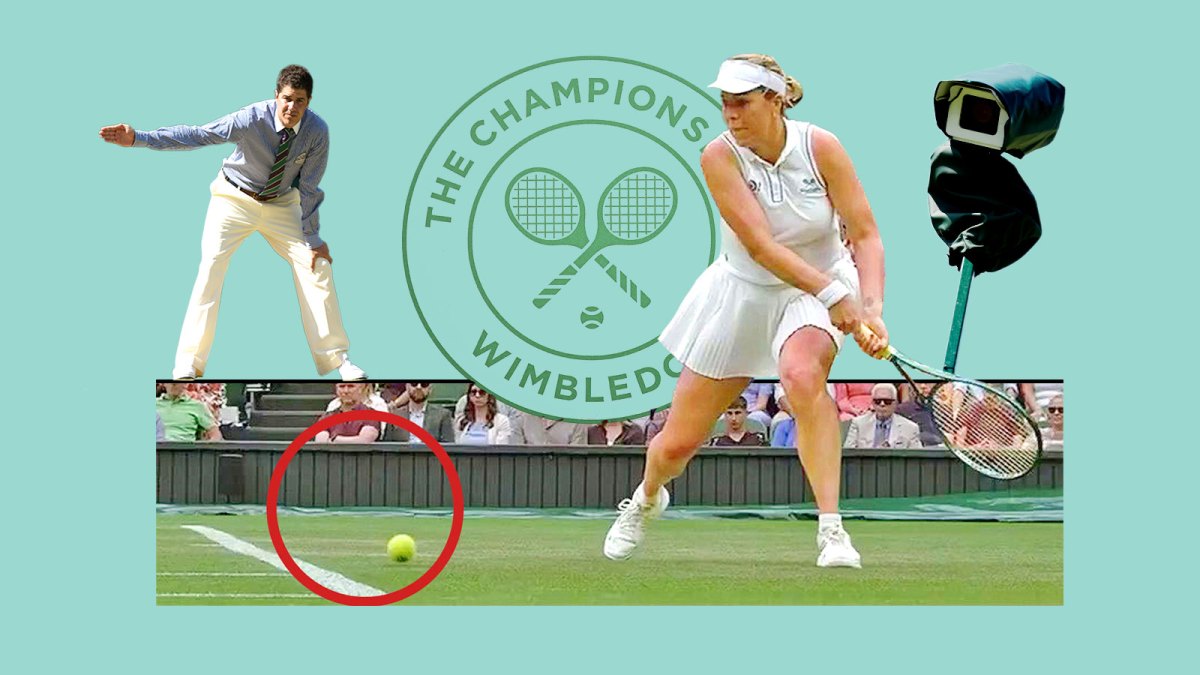Amid all the frenzied debate about the accuracy and reliability of Hawk-Eye’s electronic line-calling (ELC) system at Wimbledon, there has been one patently obvious flaw during its use across the tennis tour: the lack of any visual indication after a ball has landed out.
Those who have sat watching matches at Wimbledon this fortnight will know the feeling that this correspondent has repeatedly experienced at the biggest tournaments around the world. The awkward two to three seconds in which you are unsure about who has just won the point because it has been difficult to hear the automated audible call, perhaps because of a loud roar from the crowd or the constant din from air-conditioning units attached to roofs. It is only when the scoreboard updates that the confusion is settled.
In the bygone era of human line judges, there was no issue in this regard. Even if it was challenging to pick up the shout of “out” from the mouths of the staff standing to the back or side of the court, confirmation would immediately follow with an outstretched arm to the side. Even balls that narrowly landed in were occasionally followed with a visual signal of both hands hanging downwards in a central position.

There is little hope of line judges returning to SW19 next year, despite the deepening ELC controversies
ALBERTO PEZZAL/AP
Now, it can sometimes feel like a guessing game in which you are trying to gauge the winner of the point from the reactions of the players. It is particularly challenging for those spectators who are deaf, and it is understood that both the All England Club and the LTA — which organised the warm-up tournaments at the likes of Queen’s and Eastbourne — have received letters and emails pointing this out.
It is surprising that this issue has never been addressed in a system that was first tested eight years ago at an under-21 tournament titled the ATP Next Gen Finals in Milan, but safe to say it will be added as feedback to “The List” that the All England Club famously puts together after each championships to improve on the following year. One high-ranking official here privately acknowledged to The Times that it was worth considering the potential addition of a visual “out” display on the courtside scoreboards.
There are some people who go as far as suggesting that ELC be done away with completely after several controversies here, but there is no prospect of that. Tim Henman, the normally mild-mannered former world No4 who has been a member of the All England Club’s board for several years, summed up the firm and impassioned defence here of the system when he described criticism of its accuracy by the likes of Jack Draper and Emma Raducanu as “utter garbage”.
Undoubtedly, however, there are flaws to iron out in tennis’s use of officiating technology. The most notable incident on Sunday during the match between Sonay Kartal and Anastasia Pavlyuchenkova highlighted this, in which Kartal clearly hit a long backhand that was not picked up by ELC. The reason for this, as the All England Club later explained, was that some of the cameras had been accidentally deactivated on Pavlyuchenkova’s side of the court by a human operator.
Please enable cookies and other technologies to view this content. You can update your cookies preferences any time using privacy manager.
Enable cookiesAllow cookies once
A small change was subsequently made to the system in which a manual deactivation, involving the unticking of a box, was no longer possible. In the long term, though, organisers may wish to consider allowing umpires to conduct an additional video review to clear any confusion and resolve these issues. A quick check, for example, of a replay of Kartal’s backhand would have clearly shown that the ball landed long.
An incident on Tuesday flagged up another potential tweak when a rally between Taylor Fritz and Karen Khachanov was brought to a sudden halt when a call of “fault” was made after the third shot, which landed inside the lines. The reason for this was that Fritz had begun his service motion when a ballboy was still running across the court, meaning that the system considered the third shot to be the start of the point rather than the serve. Perhaps then, in future, the umpire should make sure that all ballboys and ballgirls are back in their positions before the point can get under way.

The decision to replace human line judges with the ELC system has been far from painless for Wimbledon chiefs
ALAN BURLES/PA
The irony is that this same Hawk-Eye technology has been considered successful at Wimbledon since 2007, first as the popular challenge system alongside human line judges before becoming fully integrated this year as a live officiating tool. Twelve cameras are placed around the court to capture the movement of the ball, with the computer interpreting its location in real time. This produces a 3D representation of the court, showing the trajectory and landing point of the ball.
The hub for all of this is referred to as “The Rack Room”, which is tucked away in a quiet corner of the site behind the broadcast centre. Inside are approximately 50 operators — all placed on a rota system (two hours on, one hour off) — with each court covered by eight screens at specific desks. A review official is also assigned to every court. This is the person contacted by the umpire on the old-school telephone sets when an issue arises.
Installation of the system started on site in mid-May and took six weeks, involving rigorous testing to meet strict certification standards. More discreet testing had also taken place during last year’s championships as a part of the wargaming process.

Using 12 cameras set up discreetly around the court, the technology tracks balls — at least when it is turned on
MIKE EGERTON/PA
It must be said that ELC has been used largely issue-free in tennis for some time now. Its introduction to the sport was accelerated because of the Covid-19 pandemic, which forced tournament organisers to reduce the number of personnel on site. The 2021 Australian Open was the first grand-slam tournament to adopt the system in place of human line judges and it gradually spread to other events before becoming mandatory on the ATP Tour this year.
Grand-slams are outside the direct jurisdiction of the ATP, meaning that the French Open was able to continue using line judges this year. A key difference is the surface of clay, which produces ball marks on the brick dust for the umpires to quickly check in the event of any close calls. The French Tennis Federation also stated its willingness to protect a national network of line judges across all levels.
The retention of this form of officiating was not without controversy, either. There were several disputed calls during the tournament, including a key moment in the final set of the men’s final when a shot by Carlos Alcaraz was not called out. This could not be checked by the umpire because it happened mid-rally and the technology in use for broadcasting purposes subsequently showed that the ball was considerably long and the point should have gone to Jannik Sinner.
One of the main factors behind Wimbledon’s decision to introduce ELC was to avoid the risk of any controversies arising as a result of not using a system that had received the support of most players on the tour. It has always been acknowledged that it is not 100 per cent accurate, with a 2.2mm margin of error on average, but this is still considered to be far more precise than a traditional crew of line judges.
While several players have questioned whether it is more inaccurate than usual here, with some suggesting this is because of grass’s unique status as a natural surface, officials are privately adamant this is a myth that has gathered legs. A video released by the ATP this year showed the difficulty for the human eye in properly tracking a fast-moving ball that looked as if it had landed out, with slow-motion frame-by-frame cameras showing it had actually clipped the back of the line.
It means that those calling for the well-dressed line judges to return to Wimbledon are set only for disappointment. No doubt there are flaws to be addressed and some changes to be made based on what we have seen here this fortnight, but ELC is here to stay in SW19.
